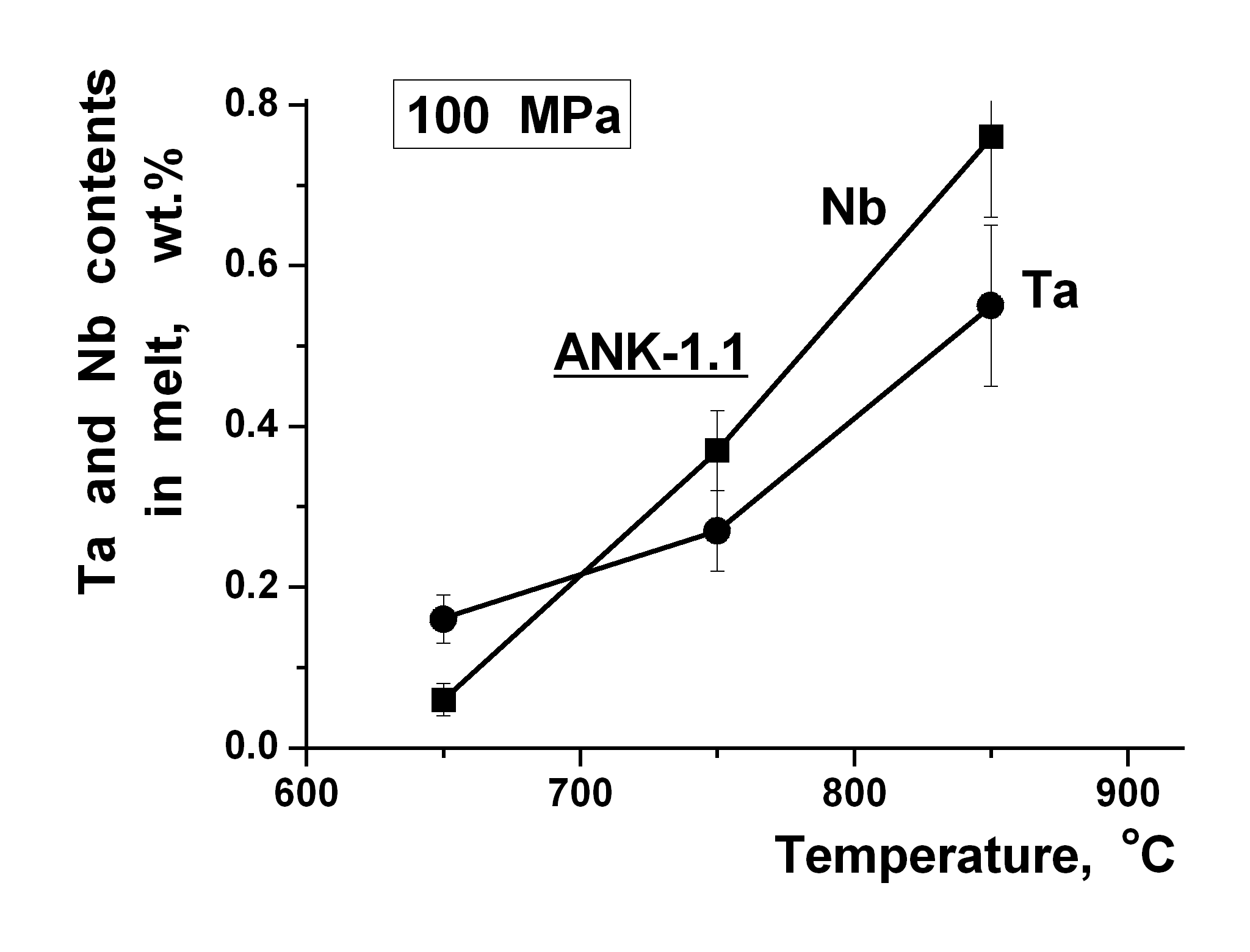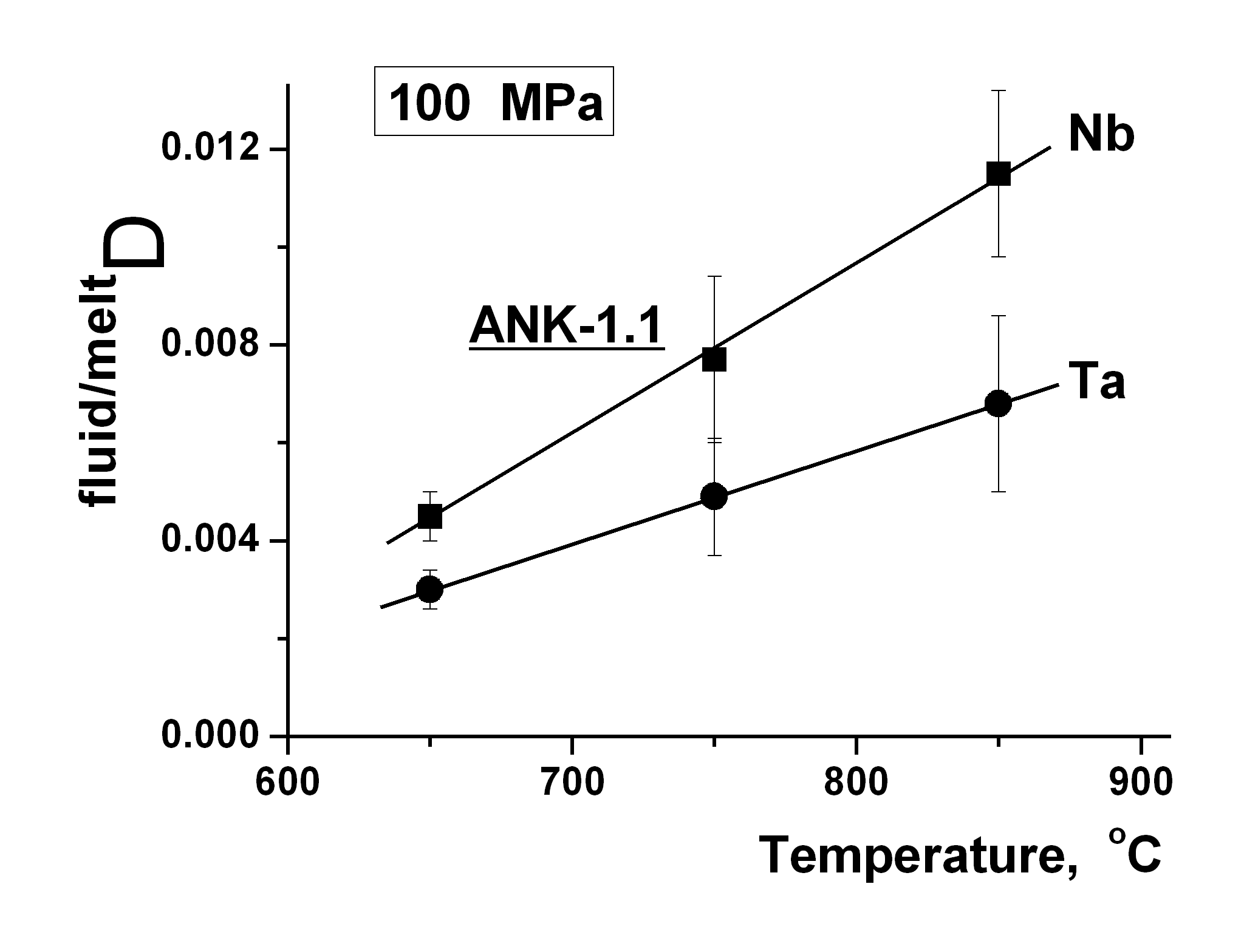|
INFLUENCE OF THE MELT COMPOSITION AND T-P CONDITIONS ON SOLUBILITY AND PARTITIONING OF Ta AND Nb IN THE SYSTEM OF AQUEOUS FLUID – GRANITOID MELT: EXPERIMENTAL DATA Chevychelov V.Yu., Borodulin G.P., Zaraisky G.P. Institute of Experimental Mineralogy RAS, Chernogolovka, Moscow region, Russia, chev@iem.ac.ru
For the last few years there is increasing geological and experimental evidences that tantalic-niobic ore mineralization in rare-metal lithium-fluoric granites (Orlovka, Etyka and others deposits) to high degree is connected with magmatic stage of forming of these granitic massifs. Quantitative data on Ta and Nb solubility in granitic melts and partitioning of these elements under fluid-magmatic interaction are necessary for modelling of possible conditions of formation of tantalic deposits of similar type. Quantitative experimental data on solubility of columbite (Mn,Fe)(Nb,Ta)2O6 in Li- and F- enriched haplogranitic melt in a wide range of change of pressure (30-400 MPa), temperature (650-850oC) and alumina, sodium and potassium contents of melts (starting A/NK (mol. Al2O3/ (Na2O+K2O)) - 0.64, 1.1 and 1.7) are obtained (Chevychelov et al., 2007). Change of melt composition has the greatest effect on columbite solubility in comparison with change of temperature and pressure. The contents Ta and Nb are maximal in alkaline melt (up to ~1.2-1.9 wt.% Ta and ~2.1-4.7 wt.% Nb), they decrease almost in order of magnitude in the melt of normal composition (up to ~0.1-0.6 wt.% Ta and ~0.06-0.8 wt.% Nb; Fig. 1) and they continue to decrease with increase of alumina content in the melt composition (up to ~0.04-0.31 wt.% Ta and ~0.05-0.17 wt.% Nb). The Nb/Ta ratio in the melt decreases as a rule with reduction of temperature. It is connected with faster reduction of Nb solubility in granitic melt with temperature drop in comparison with Ta solubility. Positive temperature dependence of columbite solubility is more strongly expressed in granitic melt with A/NK ~1.1 (Fig. 1) in comparison with alkaline-rich and alumina-rich melts. At P =100 MPa and T =650-850oC the Ta content is always higher than Nb content in alumina-rich melt (Nb/Ta ~0.5). The Nb/Ta ratio is opposite in alkaline-rich melt (Nb/Ta ~1.25-2.0), and the tantalum dominates at 650oC, and the niobium dominates at 750-850oC in the melt with A/NK ~1.1 (Fig. 1). Change of pressure in the investigated range of pressure has weaker effect on columbite solubility in comparison with effect of melt composition. It is possible to assume that at P =100 MPa the Nb content in granitic melt attains the maximum.
Fig. 1. Fig. 2. Also quantitative data on partitioning of Ta and Nb between aqueous fluoride fluid and Li- and F- enriched haplogranitic melts with the various contents of alumina, sodium and potassium are experimentally obtained at T =650-850oC and P =100 MPa (Borodulin et al., 2007). It is established that partition coefficients of Ta and Nb between fluid and granitic melt (fluid/meltD =fluidC/meltC) under the studied conditions are very low (0.001-0.007 for Ta and 0.004-0.017 for Nb). That is partitioning of these metals is sharply displaced in favour of the melt. The tantalic partition coefficients are as a whole 1.5-3 times below than the niobic partition coefficients (Fig. 2). The temperature has certain influence on partitioning of Ta and Nb, most obviously expressed for alumina-enriched melt. For this melt the coefficients of fluid/meltDTa and Nb decrease approximately 4.5-5 times with reduction of temperature from 850 up to 650oC. As a whole, partition coefficients of Nb decrease with temperature more strongly in comparison with partition coefficients of Ta (Fig. 2). The melt composition possibly has not appreciable influence on partitioning of Ta and Nb in studied system at identical temperature. At least the obtained data do not allow to estimate such influence unequivocally. The obtained results show that at fluid-magmatic interaction the niobium and especially tantalum are preserved to the end into granitic melt with decrease of temperature, not passing in the fluid, and they are concentrate in the melt in process of crystallization differentiation. It is possible to assume that columbite can crystallize directly from the melt on final subsolidus stages at high crystallinity of deeply differentiated low-temperature melts (Reyf et al., 2000; Zaraisky, 2004; Chevychelov et al., 2005). Experimentally established fact of increase of tantalum content in the melt in relation to niobium with decrease of temperature can cause known natural empirical regularity of reduction of Nb/Ta ratio in consecutive differentiates of granitic magma. Financial support was provided by the Russian Foundation for Basic Research (Grant No. 08-05-00865, No. 08-05-00835), “Leading Scientific School” (Grant No. NSh-3763.2008.5) and “Assistance Foundation of Native Science”. References Borodulin G.P., Chevychelov V.Yu., Zaraisky G.P. Partitioning of Ta and Nb between aqueous fluoride fluid and granitic melts with the various contents of alumina and alkalis at T=650-850oC and P=100 MPa // Vestn. Otd. Nauk o Zemle RAN, ¹1(25)' 2007, Moscow, IPE RAS, 2007. URL: http://www. scgis.ru/russian/cp1251/h_dgggms/1-2007/informbul-1_2007/term-22e.pdf . Zaraisky G.P. Conditions of formation rare-metal deposits connected with granitic magmatism // Smirnov collection - 2004 (Scientific-literary anthology). Editor in chief – Starostin V.I. Moscow, Foundation after the name of academician V.I. Smirnov, 2004. P.105-192 (in Russian). Chevychelov V.Yu., Zaraisky G.P., Borisovskii S.E., Borkov D.A. Effect of melt composition and temperature on the partitioning of Ta, Nb, Mn, and F between granitic (alkaline) melt and fluorine-bearing aqueous fluid: Fractionation of Ta and Nb and conditions of ore formation in rare-metal granites // Petrology, 2005. Vol. 13. No 4. P. 305-321. Translated from Petrologiya, 2005. Vol. 13. No 4. P.339-357. Chevychelov V.Yu., Zaraisky G.P., Borodulin G.P. Experimental investigation of influence of melt alkalinity, temperature and pressure on solubility of rare metals (Ta, Nb) in granitoid melt // Alkaline magmatism of the Earth and its ore content: Materials of the international meeting. Donetsk. Kiev, 2007. P.259-263 (in Russian). Reyf F.G., Seltmann R., Zaraisky G.P. The role of magmatic processes in the formation of banded Li,F-enriched granites from the Orlovka tantalum deposit, Transbaikalia, Russia: microthermometric evidence // The Canadian Mineralogist., 2000. V. 38. P.915-936.
|

